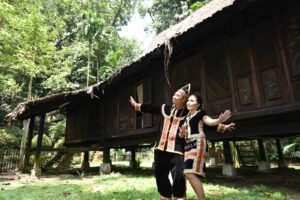Exploring Bookan, a Fading Language of the Murut People in Sabah, Malaysia
The Bookan language is an endangered language spoken by the Murut people, an indigenous group residing in the state of Sabah, Malaysia. This unique language, which is rapidly declining in usage, holds immense cultural value and is an important part of the Murut identity. In this article, we will delve into the history, significance, current status, and efforts to preserve and revitalize the Bookan language.

History and Origins of Bookan Language
The origins of the Bookan language can be traced back to the Austronesian language family, which also includes languages such as Malay and Indonesian. It is believed that the Murut people migrated to Sabah and settled in the region thousands of years ago, bringing with them their distinct language. Over time, the Bookan language developed its own unique features and dialects, influenced by the surrounding languages and cultures.
Importance of Bookan Language to the Murut People
The Bookan language holds immense importance for the Murut people as it serves as a crucial link to their cultural heritage and traditions. It is through this language that the Murut people communicate their history, myths, and ancestral knowledge. The language is deeply intertwined with their identity, acting as a repository of their customs, values, and beliefs. Moreover, it reinforces their sense of community and strengthens social bonds among the Murut people.

Current Status of Bookan Language
Sadly, the Bookan language is currently facing a critical threat of extinction. Due to various socio-economic factors and external influences, the younger generation of Murut people are increasingly shifting towards more dominant languages such as Malay and English. As a result, the usage and fluency of the Bookan language is rapidly declining, endangering its preservation and future existence.
Factors Contributing to the Language’s Decline
Several factors contribute to the decline of the Bookan language. Globalization, modernization, and the influence of mainstream media play a significant role in shaping the linguistic preferences of the younger generation. The lack of formal education in the Bookan language further hampers its transmission to future generations. Additionally, urbanization and migration to urban areas have caused a disconnection from rural communities where the language is predominantly spoken.
Efforts to Preserve the Bookan Language
Recognizing the importance of preserving the Bookan language, various initiatives have been undertaken. Local community leaders, linguists, and educators are working collaboratively to develop language documentation projects, including dictionaries, grammar guides, and teaching materials. Efforts are also being made to promote intergenerational language transmission through cultural events, workshops, and language immersion programs.

Linguistic Features of the Bookan Language
The Bookan language is characterized by its unique linguistic features. It exhibits rich morphology, employing affixes to indicate tense, mood, and aspect. The language is known for its complex sentence structures and noun classifiers that reflect the Murut people’s close relationship with nature. Like many indigenous languages, it also places a strong emphasis on oral traditions, with storytelling and oral literature playing a significant role in language preservation.
Unique Vocabulary and Grammar of the Bookan Language
The Bookan language possesses a rich vocabulary and grammar system that distinguishes it from other languages in the region. It has specific words to describe natural phenomena, traditional practices, and cultural artifacts. The grammar structure includes a subject-verb-object word order, and the language uses a system of verb affixes to convey different aspects of an action. These unique linguistic features make the Bookan language a fascinating subject of study for linguists and researchers.
Bookan Language’s Cultural Significance
Beyond its linguistic aspects, the Bookan language is deeply intertwined with the cultural fabric of the Murut people. It serves as a vehicle for the transmission of cultural values, customs, and traditional knowledge. The language plays a pivotal role in ceremonies, rituals, and social gatherings, reinforcing the Murut people’s shared identity and fostering a sense of belonging. It is through the Bookan language that the Murut people maintain a strong connection to their ancestral heritage.
Challenges in Documenting Bookan Language
Documenting the Bookan language presents numerous challenges. The scarcity of resources and funding, coupled with the limited number of fluent speakers, make it difficult to compile comprehensive linguistic materials. Additionally, the language’s complex grammar and oral traditions pose significant obstacles to its systematic documentation. However, dedicated linguistic researchers and community members are committed to overcoming these challenges to safeguard this linguistic treasure.
Revitalization Initiatives for Bookan Language
To revitalize the Bookan language, various revitalization initiatives are being undertaken. These include the establishment of language revitalization programs, where language classes and workshops are conducted to encourage language acquisition and usage. Collaborative efforts between community members, educational institutions, and government bodies aim to integrate the Bookan language into formal education, ensuring its transmission to future generations.
Future Outlook for the Bookan Language
The future of the Bookan language remains uncertain, but the efforts to preserve and revitalize it offer hope. It is crucial for individuals, communities, and policymakers to recognize the value of linguistic diversity and the cultural heritage it represents. By supporting ongoing initiatives, promoting awareness, and fostering intergenerational language transmission, the Bookan language can be given a new lease on life, ensuring the Murut people’s linguistic and cultural legacy endures for generations to come.